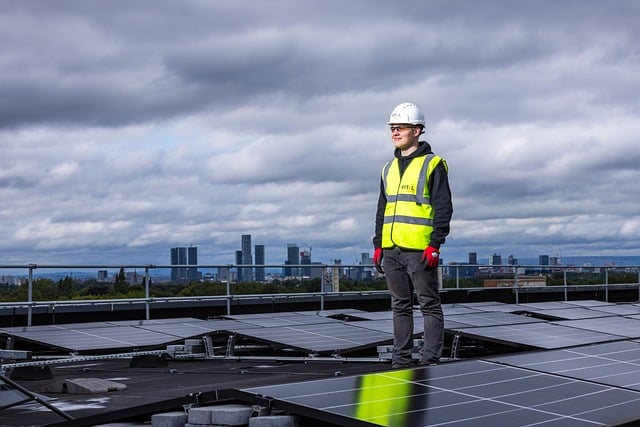“Illuminate Your Knowledge: Mastering the Essentials of Solar Wiring Types.”
Understanding the different types of solar wiring is essential for optimizing the performance and safety of solar energy systems. Solar wiring refers to the electrical connections and configurations used to connect solar panels, inverters, batteries, and other components within a solar power system. There are several wiring configurations, including series, parallel, and series-parallel setups, each with its own advantages and disadvantages. Proper wiring not only ensures efficient energy transfer but also impacts the overall system voltage, current, and safety measures. By comprehending these wiring types, installers and users can make informed decisions that enhance the reliability and efficiency of their solar energy systems.
Series Wiring: Advantages and Disadvantages
When it comes to solar energy systems, understanding the various wiring configurations is crucial for optimizing performance and efficiency. One of the most common methods employed in solar installations is series wiring. This approach involves connecting solar panels in a linear fashion, where the positive terminal of one panel connects to the negative terminal of the next. While series wiring offers several advantages, it also comes with its own set of disadvantages that must be carefully considered.
One of the primary advantages of series wiring is its simplicity. The configuration is straightforward, making it easier to design and install. When solar panels are wired in series, the voltage of each panel adds up, which can be particularly beneficial in systems where space is limited. For instance, if you have two 300-watt panels, wiring them in series can yield a total output of 600 watts at a higher voltage, which can be advantageous for reducing current and minimizing losses in the wiring. This higher voltage can also allow for the use of thinner wires, which can reduce material costs and simplify installation.
Moreover, series wiring can enhance the overall efficiency of the solar system under certain conditions. When panels are connected in series, the current flowing through the system remains constant, which can lead to improved performance in low-light conditions. This is particularly important in regions where weather conditions can be unpredictable, as it allows the system to maintain a more consistent output even when some panels may be partially shaded or dirty. In such scenarios, the series configuration can help ensure that the entire system continues to function effectively.
However, despite these advantages, series wiring is not without its drawbacks. One significant disadvantage is the impact of shading on the performance of the entire string of panels. In a series configuration, if one panel is shaded or underperforming, it can significantly reduce the output of the entire string. This phenomenon, known as the “Christmas light effect,” occurs because the current flowing through the series is limited by the panel with the lowest output. Consequently, even a small amount of shading can lead to a substantial decrease in energy production, which can be a critical issue in installations where shading is a concern.
Additionally, series wiring can complicate system maintenance and troubleshooting. If a single panel fails or experiences a malfunction, it can affect the entire series, making it challenging to identify and rectify issues. This can lead to increased downtime and potentially higher maintenance costs, as technicians may need to inspect multiple panels to determine the source of the problem.
In conclusion, while series wiring offers several benefits, including simplicity, higher voltage output, and improved performance in certain conditions, it also presents challenges, particularly regarding shading and maintenance. Therefore, when designing a solar energy system, it is essential to weigh these advantages and disadvantages carefully. By understanding the implications of series wiring, homeowners and installers can make informed decisions that align with their specific energy needs and environmental conditions, ultimately leading to a more efficient and reliable solar energy system.
Parallel Wiring: Benefits and Considerations

Parallel wiring is a popular configuration in solar energy systems, offering distinct advantages that make it an appealing choice for many homeowners and businesses. This method involves connecting multiple solar panels in such a way that each panel operates independently, allowing for a more flexible and efficient energy generation process. One of the primary benefits of parallel wiring is its ability to maintain performance even when one or more panels are shaded or malfunctioning. In contrast to series wiring, where the output of the entire system can be compromised by a single underperforming panel, parallel wiring ensures that each panel contributes to the overall energy output. This characteristic is particularly advantageous in environments where shading from trees, buildings, or other obstructions is a concern.
Moreover, parallel wiring enhances the overall reliability of the solar energy system. If one panel fails or experiences a drop in performance, the remaining panels continue to function optimally, thereby minimizing the impact on the system’s total energy production. This resilience is crucial for users who rely on consistent energy generation, as it helps to ensure that their energy needs are met without significant interruptions. Additionally, the independent operation of each panel allows for easier troubleshooting and maintenance. If an issue arises, technicians can quickly identify and address the problem without needing to take the entire system offline.
Another significant advantage of parallel wiring is its flexibility in system design. This configuration allows for the easy addition of more panels in the future, accommodating the evolving energy needs of the user. For instance, if a homeowner decides to expand their solar array to increase energy production, they can simply add more panels to the existing system without needing to reconfigure the entire setup. This scalability is particularly appealing for those who may want to start with a smaller system and gradually expand as their energy requirements grow.
However, while parallel wiring offers numerous benefits, it is essential to consider some potential drawbacks. One of the primary concerns is the increased complexity of the wiring system. With multiple connections and pathways, the installation process can be more intricate than that of a series configuration. This complexity may lead to higher installation costs and requires skilled technicians to ensure that the system is set up correctly. Additionally, the use of parallel wiring can result in higher current levels flowing through the system, which necessitates the use of appropriately rated wiring and components to prevent overheating and ensure safety.
Furthermore, while parallel wiring allows for independent panel operation, it can lead to slightly lower overall voltage output compared to series configurations. This difference may require additional considerations when designing the inverter and other system components, as they must be compatible with the lower voltage levels produced by parallel connections. Therefore, it is crucial for system designers and installers to carefully evaluate the specific energy needs and site conditions before deciding on the most suitable wiring configuration.
In conclusion, parallel wiring presents a compelling option for solar energy systems, offering benefits such as enhanced performance under varying conditions, increased reliability, and design flexibility. However, it is essential to weigh these advantages against the potential complexities and safety considerations associated with this wiring method. By understanding the nuances of parallel wiring, users can make informed decisions that align with their energy goals and ensure a successful solar installation.
Series-Parallel Wiring: Combining the Best of Both Worlds
When it comes to solar energy systems, understanding the intricacies of wiring configurations is crucial for optimizing performance and efficiency. Among the various wiring methods, series-parallel wiring stands out as a hybrid approach that combines the advantages of both series and parallel configurations. This method not only enhances the overall output of a solar array but also improves its resilience to shading and other environmental factors.
To begin with, it is essential to grasp the fundamental principles of series and parallel wiring. In a series configuration, solar panels are connected end-to-end, meaning the positive terminal of one panel connects to the negative terminal of the next. This arrangement results in a cumulative voltage increase while maintaining the same current level. For instance, if three 12-volt panels are wired in series, the total output voltage becomes 36 volts, while the current remains that of a single panel. However, this setup has a significant drawback: if one panel is shaded or underperforming, it can reduce the output of the entire string, as the current is limited by the weakest link.
On the other hand, parallel wiring connects all the positive terminals together and all the negative terminals together, which allows for a constant voltage output while increasing the current. This means that if one panel is shaded, the others can still operate at their full capacity, thus maintaining a higher overall output. However, the downside of parallel wiring is that it can lead to higher current levels, which may require thicker wires and more robust components to handle the increased load safely.
By combining these two methods, series-parallel wiring effectively mitigates the limitations of each configuration. In a series-parallel setup, multiple strings of panels are wired in series, and then these strings are connected in parallel. This arrangement allows for a higher voltage output while also benefiting from the increased current capacity of parallel connections. For example, if you have four panels wired in series, and you create two such strings connected in parallel, you can achieve a significant voltage boost while ensuring that shading on one string does not cripple the performance of the entire system.
Moreover, series-parallel wiring enhances the flexibility of solar installations. It allows for easier expansion of the system, as additional panels can be added in either series or parallel without drastically altering the existing setup. This adaptability is particularly beneficial for homeowners or businesses that may want to scale their solar energy production over time. Additionally, this configuration can be tailored to match the specific voltage and current requirements of the inverter, ensuring optimal performance and efficiency.
In terms of installation, series-parallel wiring does require careful planning and consideration. It is essential to ensure that the panels used in each string are of the same type and rating to avoid imbalances that could lead to inefficiencies or damage. Furthermore, proper fusing and circuit protection are necessary to safeguard against potential overcurrent situations that may arise from the parallel connections.
In conclusion, series-parallel wiring represents a sophisticated approach to solar energy systems that harnesses the strengths of both series and parallel configurations. By understanding and implementing this method, solar energy users can maximize their system’s efficiency, enhance its resilience to shading, and enjoy greater flexibility in their energy production. As the demand for renewable energy continues to grow, mastering such wiring techniques will be essential for anyone looking to invest in solar technology.
Choosing the Right Solar Wiring for Your System
Choosing the right solar wiring for your system is a crucial step in ensuring the efficiency and longevity of your solar energy setup. As solar technology continues to evolve, understanding the various types of wiring available can significantly impact the performance of your solar panels. The primary types of wiring used in solar installations include photovoltaic (PV) wire, THHN wire, and USE-2 wire, each designed for specific applications and environments.
PV wire is specifically engineered for solar applications, making it a popular choice among installers. This type of wire is built to withstand the harsh conditions often encountered in outdoor environments, such as extreme temperatures, moisture, and UV exposure. The insulation on PV wire is typically made from a durable material that resists degradation, ensuring that the wiring maintains its integrity over time. Additionally, PV wire is available in various gauges, allowing for flexibility in installation based on the size and power output of the solar system. When selecting PV wire, it is essential to consider the voltage drop, which can affect the overall efficiency of the system. A lower gauge wire can minimize resistance and improve performance, particularly in larger installations.
On the other hand, THHN wire, which stands for Thermoplastic High Heat-resistant Nylon-coated wire, is commonly used in residential and commercial electrical systems. While it is not specifically designed for solar applications, it can be utilized in certain aspects of a solar installation, particularly for indoor wiring or in conduit. THHN wire is known for its versatility and is often favored for its ability to handle high temperatures and its resistance to moisture. However, it is important to note that THHN wire may not be suitable for direct burial or outdoor applications without additional protection, as it lacks the UV resistance found in PV wire. Therefore, when considering THHN for your solar system, it is vital to assess the specific installation environment and ensure that the wire is adequately protected.
Another option is USE-2 wire, which is designed for underground service entrance applications. This type of wire is particularly useful for connecting solar panels to inverters or batteries in off-grid systems. USE-2 wire is rated for direct burial, making it an excellent choice for installations where the wiring will be exposed to soil or moisture. Like PV wire, USE-2 wire is also resistant to UV rays, ensuring that it can withstand outdoor conditions without degrading. When choosing USE-2 wire, it is essential to consider the ampacity, or the maximum amount of current the wire can safely carry, to ensure that it meets the demands of your solar system.
In addition to selecting the appropriate type of wire, it is also crucial to consider the connectors and junction boxes used in the installation. Proper connectors can prevent energy loss and ensure a secure connection between components. Furthermore, using weatherproof junction boxes can protect wiring from the elements, enhancing the overall durability of the system.
Ultimately, the choice of solar wiring will depend on various factors, including the specific requirements of your solar installation, local building codes, and environmental conditions. By understanding the differences between PV wire, THHN wire, and USE-2 wire, you can make an informed decision that will optimize the performance and reliability of your solar energy system. Investing time in selecting the right wiring will not only enhance efficiency but also contribute to the long-term success of your renewable energy investment.
Q&A
1. **Question:** What are the main types of solar wiring configurations?
**Answer:** The main types of solar wiring configurations are series wiring, parallel wiring, and series-parallel wiring.
2. **Question:** What is series wiring in solar systems?
**Answer:** Series wiring connects solar panels end-to-end, increasing the voltage while keeping the current the same, which is useful for systems requiring higher voltage.
3. **Question:** What is parallel wiring in solar systems?
**Answer:** Parallel wiring connects solar panels side-by-side, maintaining the same voltage while increasing the current, which is beneficial for systems that require more power output.
4. **Question:** What is series-parallel wiring in solar systems?
**Answer:** Series-parallel wiring combines both series and parallel configurations, allowing for increased voltage and current, optimizing performance and providing redundancy in case of panel failure.
Conclusion
Understanding the different types of solar wiring is essential for optimizing the performance and safety of solar energy systems. By recognizing the distinctions between series, parallel, and series-parallel configurations, as well as the implications of each on voltage, current, and overall system efficiency, installers and users can make informed decisions that enhance energy production and reliability. Proper wiring not only maximizes energy output but also minimizes potential issues related to shading, module mismatch, and system maintenance, ultimately contributing to the effectiveness and longevity of solar installations.




